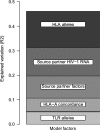Host genetic and viral determinants of HIV-1 RNA set point among HIV-1 seroconverters from sub-saharan Africa
- PMID: 25473042
- PMCID: PMC4338863
- DOI: 10.1128/JVI.01573-14
Host genetic and viral determinants of HIV-1 RNA set point among HIV-1 seroconverters from sub-saharan Africa
Abstract
We quantified the collective impact of source partner HIV-1 RNA levels, human leukocyte antigen (HLA) alleles, and innate responses through Toll-like receptor (TLR) alleles on the HIV-1 set point. Data came from HIV-1 seroconverters in African HIV-1 serodiscordant couple cohorts. Linear regression was used to determine associations with set point and R(2) to estimate variation explained by covariates. The strongest predictors of set point were HLA alleles (B*53:01, B*14:01, and B*27:03) and plasma HIV-1 levels of the transmitting partner, which explained 13% and 10% of variation in set point, respectively. HLA-A concordance between partners and TLR polymorphisms (TLR2 rs3804100 and TLR7 rs179012) also were associated with set point, explaining 6% and 5% of the variation, respectively. Overall, these factors and genital factors of the transmitter (i.e., male circumcision, bacterial vaginosis, and use of acyclovir) explained 46% of variation in set point. We found that both innate and adaptive immune responses, together with plasma HIV-1 levels of the transmitting partner, explain almost half of the variation in viral load set point.
Importance: After HIV-1 infection, uncontrolled virus replication leads to a rapid increase in HIV-1 concentrations. Once host immune responses develop, however, HIV-1 levels reach a peak and subsequently decline until they reach a stable level that may persist for years. This stable HIV-1 set point represents an equilibrium between the virus and host responses and is predictive of later disease progression and transmission potential. Understanding how host and virus factors interact to determine HIV-1 set point may elucidate novel mechanisms or biological pathways for treating HIV-1 infection. We identified host and virus factors that predict HIV-1 set point in people who recently acquired HIV-1, finding that both innate and adaptive immune responses, along with factors that likely influence HIV-1 virulence and inoculum, explain ∼46% of the variation in HIV-1 set point.
Copyright © 2015, American Society for Microbiology. All Rights Reserved.
Figures


References
-
- Lavreys L, Baeten JM, Chohan V, McClelland RS, Hassan WM, Richardson BA, Mandaliya K, Ndinya-Achola JO, Overbaugh J. 2006. Higher set point plasma viral load and more-severe acute HIV type 1 (HIV-1) illness predict mortality among high-risk HIV-1-infected African women. Clin Infect Dis 42:1333–1339. doi:10.1086/503258. - DOI - PubMed
-
- Lingappa JR, Hughes JP, Wang RS, Baeten JM, Celum C, Gray GE, Stevens WS, Donnell D, Campbell MS, Farquhar C, Essex M, Mullins JI, Coombs RW, Rees H, Corey L, Wald A. 2010. Estimating the impact of plasma HIV-1 RNA reductions on heterosexual HIV-1 transmission risk. PLoS One 5:e12598. doi:10.1371/journal.pone.0012598. - DOI - PMC - PubMed
-
- Lingappa JR, Thomas KK, Hughes JP, Baeten JM, Wald A, Farquhar C, Fife KH, Campbell MS, Kapiga S, Mullins JI. 2013. Partner characteristics predicting HIV-1 setpoint in sexually acquired HIV-1 among African seroconverters. AIDS Res Hum Retrovir 29:164–171. doi:10.1089/aid.2012.0206. - DOI - PMC - PubMed
Publication types
MeSH terms
Substances
Grants and funding
LinkOut - more resources
Full Text Sources
Other Literature Sources
Medical
Research Materials

